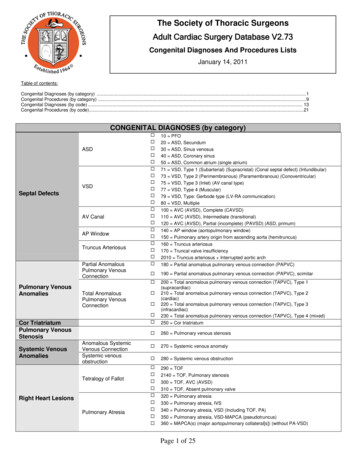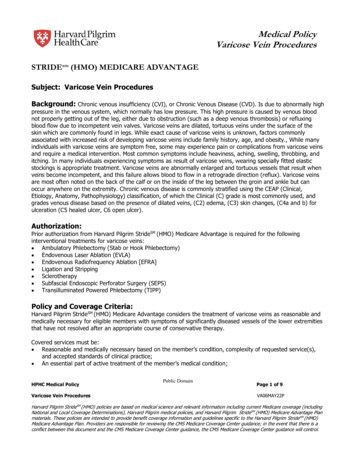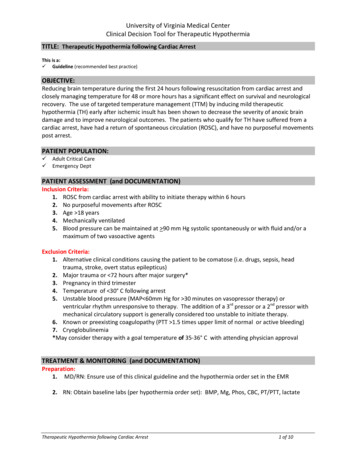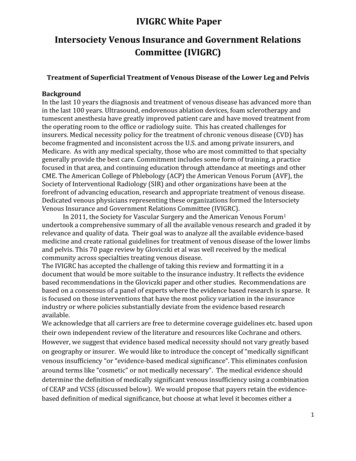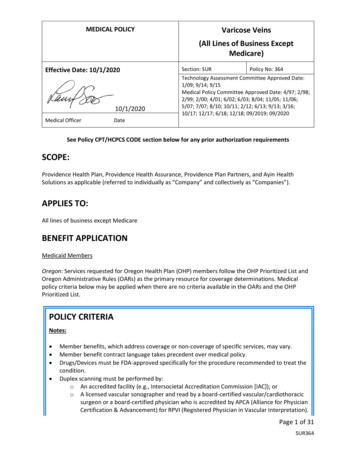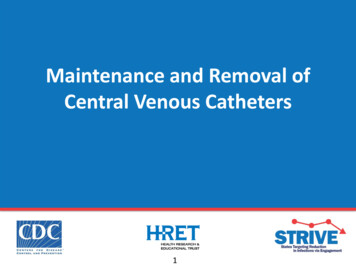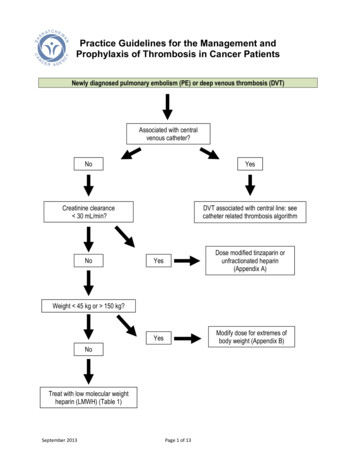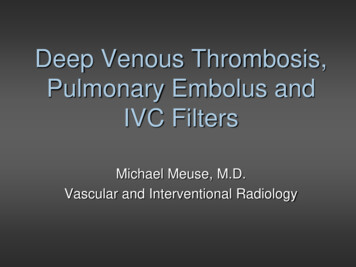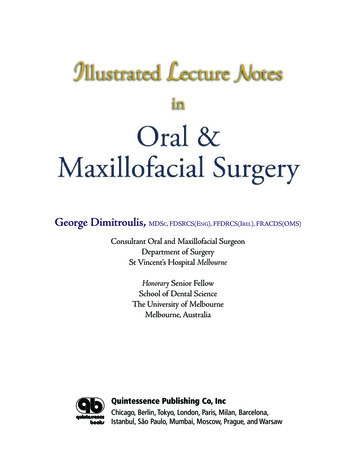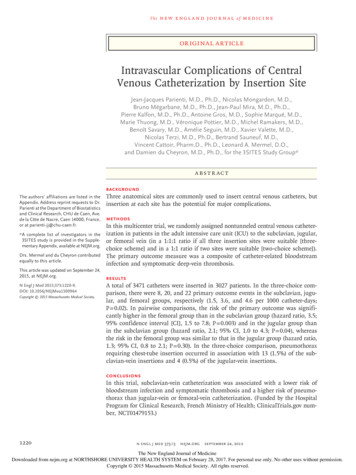
Transcription
Then e w e ng l a n d j o u r na lofm e dic i n eOriginal ArticleIntravascular Complications of CentralVenous Catheterization by Insertion SiteJean‑Jacques Parienti, M.D., Ph.D., Nicolas Mongardon, M.D.,Bruno Mégarbane, M.D., Ph.D., Jean‑Paul Mira, M.D., Ph.D.,Pierre Kalfon, M.D., Ph.D., Antoine Gros, M.D., Sophie Marqué, M.D.,Marie Thuong, M.D., Véronique Pottier, M.D., Michel Ramakers, M.D.,Benoît Savary, M.D., Amélie Seguin, M.D., Xavier Valette, M.D.,Nicolas Terzi, M.D., Ph.D., Bertrand Sauneuf, M.D.,Vincent Cattoir, Pharm.D., Ph.D., Leonard A. Mermel, D.O.,and Damien du Cheyron, M.D., Ph.D., for the 3SITES Study Group* A BS T R AC TBACKGROUNDThe authors’ affiliations are listed in theAppendix. Address reprint requests to Dr.Parienti at the Department of Biostatisticsand Clinical Research, CHU de Caen, Ave.de la Côte de Nacre, Caen 14000, France,or at parienti-jj@ chu-caen . fr.* A complete list of investigators in the3SITES study is provided in the Supplementary Appendix, available at NEJM.org.Drs. Mermel and du Cheyron contributedequally to this article.This article was updated on September 24,2015, at NEJM.org.N Engl J Med 2015;373:1220-9.DOI: 10.1056/NEJMoa1500964Copyright 2015 Massachusetts Medical Society.Three anatomical sites are commonly used to insert central venous catheters, butinsertion at each site has the potential for major complications.METHODSIn this multicenter trial, we randomly assigned nontunneled central venous catheterization in patients in the adult intensive care unit (ICU) to the subclavian, jugular,or femoral vein (in a 1:1:1 ratio if all three insertion sites were suitable [threechoice scheme] and in a 1:1 ratio if two sites were suitable [two-choice scheme]).The primary outcome measure was a composite of catheter-related bloodstreaminfection and symptomatic deep-vein thrombosis.RESULTSA total of 3471 catheters were inserted in 3027 patients. In the three-choice comparison, there were 8, 20, and 22 primary outcome events in the subclavian, jugular, and femoral groups, respectively (1.5, 3.6, and 4.6 per 1000 catheter-days;P 0.02). In pairwise comparisons, the risk of the primary outcome was significantly higher in the femoral group than in the subclavian group (hazard ratio, 3.5;95% confidence interval [CI], 1.5 to 7.8; P 0.003) and in the jugular group thanin the subclavian group (hazard ratio, 2.1; 95% CI, 1.0 to 4.3; P 0.04), whereasthe risk in the femoral group was similar to that in the jugular group (hazard ratio,1.3; 95% CI, 0.8 to 2.1; P 0.30). In the three-choice comparison, pneumothoraxrequiring chest-tube insertion occurred in association with 13 (1.5%) of the subclavian-vein insertions and 4 (0.5%) of the jugular-vein insertions.CONCLUSIONSIn this trial, subclavian-vein catheterization was associated with a lower risk ofbloodstream infection and symptomatic thrombosis and a higher risk of pneumothorax than jugular-vein or femoral-vein catheterization. (Funded by the HospitalProgram for Clinical Research, French Ministry of Health; ClinicalTrials.gov number, NCT01479153.)1220n engl j med 373;13nejm.orgSeptember 24, 2015The New England Journal of MedicineDownloaded from nejm.org at NORTHSHORE UNIVERSITY HEALTH SYSTEM on February 28, 2017. For personal use only. No other uses without permission.Copyright 2015 Massachusetts Medical Society. All rights reserved.
Complications of Catheterization by Insertion SiteSquired nontunneled central venous vascular access through a new venipuncture, and wereconsidered by the physician inserting the catheter to be suitable candidates for venous catheterization in at least two of the following threesites: the subclavian veins, the jugular veins, orthe femoral veins. The determination that a venous access site was suitable (or usable) forcatheterization was based on clinician judgment.More than one catheter per patient could be included in the trial. Written informed consentwas obtained from all participants or from theirproxies in cases of impaired decision-makingcapacity at the time of enrollment.If all three venous access sites (subclavian,jugular, and femoral) were considered suitablefor catheter placement, the catheterization sitewas assigned in a 1:1:1 randomization scheme(three-choice scheme). If one of the three siteswas not suitable on both the left and right sidesof the body, the catheterization site was assignedin a 1:1 randomization scheme for the other twosites (two-choice scheme), an approach termed“selective exclusion.”13 If only one site was suitable, that catheterization procedure was not included in the study. Randomization was stratified according to ICU and according to the useof antibiotic therapy versus no use of antibioticMe thodstherapy14; it was implemented by means of aStudy Design and Oversightcentralized 24-hour, web-based or telephoneThe 3SITES study was a multicenter randomized, interactive computerized response system (EOL,controlled trial conducted in four university- MedSharing), with the use of permuted-blockaffiliated hospitals and five general hospitals, randomization with varying block sizes.representing 10 ICUs, in France from December2011 through June 2014. The study was supported Trial Proceduresby funds from the French Ministry of Health All participating ICUs followed the French HauteProgramme Hospitalier de Recherche Clinique Autorité de Santé checklist15 and U.S. guidelinesNational to the Délégation de la Recherche Cli- for preventing catheter-related infections.16 Resinique et de l’Innovation of the Caen University dents or staff physicians who had performed atHospital. The first author designed the study. least 50 previous procedures inserted the catheCareFusion provided chlorhexidine products free ters or supervised the catheterization in the ICU.of charge; no other commercial entity contributed Maximal sterile barrier precautions were used,to this trial. The research ethics committee at including surgical hand antisepsis,17 sterile gloves,Caen University approved the study protocol (avail- surgical long-sleeved gowns, caps, and masks.able with the full text of this article at NEJM.org) Patients were covered by sterile drapes. Antisepfor all the participating centers. The first author tics, dressing, and catheter products are listedanalyzed the data and vouches for the accuracy according to participating ICU in Table S1 in theand completeness of the reported data and for Supplementary Appendix, available at NEJM.org.the fidelity of the study to the protocol.None of the study catheters were antisepticimpregnated, antibiotic-impregnated, or tunneled.Patients and RandomizationCatheterization was achieved by means of thePatients 18 years of age or older were eligible for Seldinger technique with the use of anatomicalthe study if they were admitted to the ICU, re- landmarks or ultrasonographic guidance. Afterubclavian, jugular, and femoralcentral venous catheterization are associatedwith infectious, thrombotic, and mechanical complications.1 Catheter-related bloodstreaminfection has a significant effect on morbidity,mortality, and health care costs.2-4 The risk ofshort-term catheter-related bloodstream infection is influenced mainly by extraluminal microbial colonization of the insertion site,5 and suchcolonization is also associated with thrombosis.6,7 Although the importance of catheter-relateddeep-vein thrombosis has been debated,1 allthromboses have the potential to embolize. Inaddition, catheter-related deep-vein thrombosis7-9and pulmonary embolism10 may remain undiagnosed in critically ill patients undergoing mechanical ventilation.11We conducted the 3SITES multicenter studyto evaluate the risk of catheter-related bloodstream infection or symptomatic catheter-relateddeep-vein thrombosis in adult patients who hadbeen admitted to an intensive care unit (ICU).On the basis of our previous meta-analysis,12 wehypothesized that the risk of these major complications would differ according to the site ofcatheter insertion.n engl j med 373;13nejm.orgSeptember 24, 20151221The New England Journal of MedicineDownloaded from nejm.org at NORTHSHORE UNIVERSITY HEALTH SYSTEM on February 28, 2017. For personal use only. No other uses without permission.Copyright 2015 Massachusetts Medical Society. All rights reserved.
Then e w e ng l a n d j o u r na ljugular and subclavian catheterizations, chestradiography was used to confirm the position ofthe catheter tip inside the superior vena cava andto assess for pneumothorax. Catheters were notused for routine blood sampling or renal replacement therapy.Decisions to remove catheters were made independently by the physicians caring for each patient. After aseptic removal, the catheter tips weresent for quantitative culture.18 Peripheral bloodfor culture was systematically drawn at the timeof catheter removal (details are provided in theSupplementary Appendix). Patients dischargedfrom the ICU with the catheter in place hadblood drawn for culture simultaneously from aperipheral vein and the central venous catheterto determine the differential time to positivity.Within 2 days after removal of the catheter,compression ultrasonography was performedat the insertion site to confirm symptomaticcatheter-related deep-vein thrombosis and to detect asymptomatic deep-vein thrombosis. Casesof symptomatic deep-vein thrombosis and casesof asymptomatic deep-vein thrombosis were combined for some analyses and referred to as totaldeep-vein thrombosis. Data on asymptomaticdeep-vein thrombosis were missing for all patients who died or were discharged from the ICUwith the catheter in place.External, independent clinical monitors validated a randomly selected 12% of the data andall primary and secondary outcomes. Patientswere followed until ICU discharge or death.OutcomesThe primary outcome was the incidence of majorcatheter-related complications from the time ofcatheter insertion to 48 hours after catheter removal; major complications were defined as thecomposite of catheter-related bloodstream infection (Medical Dictionary for Regulatory Activities[MedDRA], version 17, code 10064687, grade 3or higher) and symptomatic deep-vein thrombosis (MedDRA, version 17, code 10062169, grade 3or higher), whichever occurred first (see the definitions in Table S2 in the Supplementary Appendix). Key secondary outcomes included the timeto catheter-tip colonization and time to totaldeep-vein thrombosis after catheter removal.A diagnosis of catheter-related bloodstreaminfection required catheter-tip colonization withthe same phenotypic microorganism isolatedfrom a peripheral blood culture.16 For a diagnosis1222n engl j med 373;13ofm e dic i n eof catheter-related bloodstream infection with apotential skin contaminant, two separate peripheral-blood cultures had to grow the same microorganism that colonized the catheter tip. Colonization of the catheter tip was defined as 1000or more colony-forming units per milliliter.18 Anadjudication committee that was unaware of thestudy-group assignments reviewed all suspectedcases of catheter-related bloodstream infection.If a patient had signs or symptoms of catheterrelated deep-vein thrombosis, compression ultrasonography was used to confirm the diagnosis.The ultrasonography-confirmed diagnosis servedas the deep-vein thrombosis component of theprimary outcome.The secondary safety outcome was the rateof major mechanical complications (grade 3 orhigher) during insertion of the central venouscatheter and follow-up. Mechanical complicationswere defined in accordance with the modifiedNational Cancer Institute Common TerminologyCriteria for Adverse Events, version 4.0 (definitions are provided in Table S2 in the Supplementary Appendix), with the modification that pneumothorax requiring chest-tube insertion wasclassified as grade 3 instead of grade 2.Statistical AnalysisOur sample-size estimation is described in theSupplementary Appendix. We estimated that atotal sample of 3333 catheters was required,given our initial assumptions about the incidence of catheter-related complications.The statistical unit of analysis was the catheter. Analyses followed the intention-to-treatprinciple. A per-protocol sensitivity analysis excluded catheters that were not inserted in theallocated site and side of the body because offailure to gain vascular access. For cases inwhich catheter-tip culture data and blood-culturedata were missing, follow-up was censored atcatheter removal or at ICU discharge with thecatheter, whichever occurred first. Completecase and multiple-imputation sensitivity analyses were also performed (described in the Supplementary Appendix).The incidence of the primary outcome wascompared among the three insertion sites in thethree-choice comparison with the use of theoverall log-rank test. Pairwise comparisons wereconducted (combining insertion-site groups fromamong the catheters that were randomized in thethree-choice scheme with the relevant groups fromnejm.orgSeptember 24, 2015The New England Journal of MedicineDownloaded from nejm.org at NORTHSHORE UNIVERSITY HEALTH SYSTEM on February 28, 2017. For personal use only. No other uses without permission.Copyright 2015 Massachusetts Medical Society. All rights reserved.
Complications of Catheterization by Insertion Site7559 Catheter insertions were screened4088 Were excluded becauseonly one site was available3471 Underwent randomization2532 Were assigned to 1:1:1939 Were assigned to 1:11016 Were assigned to subclavian site843 Had all sites available138 Had femoral site excluded35 Had jugular site excluded1284 Were assigned to jugular site845 Had all sites available300 Had subclavian site excluded139 Had femoral site excluded1171 Were assigned to femoral site844 Had all sites available296 Had subclavian site excluded31 Had jugular site excluded866 Were inserted in assigned site51 Were inserted in the femoral site96 Were inserted in the jugular site3 Were inserted in the contralateralsubclavian site1174 Were inserted in assigned site29 Were inserted in the subclavian site61 Were inserted in the femoral site20 Were inserted in the contralateraljugular site1114 Were inserted in assigned site4 Were inserted in the subclavian site51 Were inserted in the jugular site2 Were inserted in the contralateralfemoral site843 Were included in the intentionto-treat three-choice comparison878 Were included in the intentionto-treat pairwise subclavian-versusfemoral comparison981 Were included in the intentionto-treat pairwise subclavian-versusjugular comparison845 Were included in the intentionto-treat three-choice comparison984 Were included in the intentionto-treat pairwise jugular-versussubclavian comparison1145 Were included in the intentionto-treat pairwise jugular-versusfemoral comparison844 Were included in the intentionto-treat three-choice comparison875 Were included in the intentionto-treat pairwise femoral-versussubclavian comparison1140 Were included in the intentionto-treat pairwise femoral-versusjugular comparisonFigure 1. Screening and Randomization of Catheter Insertions.Pairwise comparisons combine insertion-site groups from among the catheters that were randomized in the threechoice scheme with the relevant groups from the relevant two-choice scheme. For example, the subclavian insertionsite group that was included in the subclavian-versus-femoral pairwise comparison included 878 catheters: the 843catheters assigned in the three-choice scheme (i.e., with all three sites available) plus the 35 catheters in patientsfor whom the jugular site was excluded.the relevant two-choice scheme [Fig. 1]) with theuse of a Cox model that included catheter site,stratification variables, and design variables (inclusion in the three-choice or the relevant two-choicescheme).13 A robust sandwich covariance estimatewas used to account for a possible clusteringeffect of multiple catheters per patient. A subsample sensitivity analysis that included onerandomly selected catheter per patient was performed. The proportionality assumption was confirmed visually and tested by including the site asa time-dependent covariate in the Cox model.The intention-to-treat secondary safety outcomewas analyzed by means of a random-intercept logistic regression. Planned subgroup analyses of theprimary outcome were conducted by testing then engl j med 373;13interaction term between each pairwise comparison and the use of alcoholic chlorhexidine for cutaneous antisepsis,19-21 antibiotic treatment,14 anticoagulation, body-mass index (the weight in kilogramsdivided by the square of the height in meters)greater than 28,9 and selective site exclusion.13 Sim ilarly, subgroup analyses for the secondary safety outcome were conducted according to whetherultrasonography was used to guide insertion.22We used SAS software, version 9.4 (SAS institute), for the statistical analyses. The Holm–Bonferroni method23 was used to account formultiple testing of the primary outcome in thetwo superiority pairwise comparisons. Therefore,a P value of less than 0.025 was considered to indicate statistical significance for the lower P value,nejm.orgSeptember 24, 20151223The New England Journal of MedicineDownloaded from nejm.org at NORTHSHORE UNIVERSITY HEALTH SYSTEM on February 28, 2017. For personal use only. No other uses without permission.Copyright 2015 Massachusetts Medical Society. All rights reserved.
61 (7.2)Parenteral nutrition — no. (%)* Plus–minus values are means SD. Numbers in the table are numbers of catheters; therefore, some patients are included more than once. The lack of independence between observationswas taken into account in the generalized-estimating-equation models for the comparisons between groups, and none of the variables differed significantly between groups in these models.† These comparisons combine insertion-site groups from among the catheters that were randomized in the three-choice scheme with the relevant groups from the relevant two-choice scheme.‡ SAPS II denotes Simplified Acute Physiology Score II (values range from 0 to 163 points, with higher scores indicating a higher risk of death).365 (31.9)62 (5.4)70 (6.1)72 (7.3)67 (6.8)56 (6.4)68 (7.8)647 (56.5)49 (5.8)47 (5.6)368 (32.3)656 (57.5)555 (56.6)311 (31.7)308 (31.3)545 (55.4)487 (55.5)259 (29.5)272 (31.1)489 (55.9)259 (30.7)257 (30.4)Anticoagulation therapy — no. (%)249 (29.5)472 (55.9)457 (54.1)Antibiotic therapy — no. (%)466 (55.3)22 (1.9)22 (1.9)23 (2.3)18 (1.8)25 (2.8)23 (2.6)17 (2.0)14 (1.7)Tracheotomy — no. (%)11 (1.3)15 (1.8)Neutrophil count 500/mm3 — no. (%)19 (2.3)15 (1.3)36 (3.1)26 (2.3)6 (0.6)16 (1.6)6 (0.7)11 (1.3)120 (10.5)8 (0.9)12 (1.4)6 (0.7)12 (1.1)13 (1.3)12 (1.2)15 (1.7)8 (0.9)236 (20.6)AIDS — no. (%)13 (1.5)140 (12.3)238 (20.9)188 (19.2)83 (8.5)82 (8.3)214 (21.7)161 (18.3)77 (8.8)97 (11.1)182 (20.8)96 (11.4)74 (8.8)175 (20.7)76 (9.0)Cancer — no. (%)Diabetes mellitus — no. (%)173 (20.5)151 (17.9)57.7 20.326.1 5.725.9 5.557.3 19.754.8 20.226.4 5.826.2 5.856.9 19.655.2 20.125.9 5.325.9 5.556.1 18.925.8 5.525.9 5.356.1 18.926.1 5.7Body-mass indexSAPS II‡57.1 19.455.1 20.2721 (63.0)63.1 16.163.0 15.1748 (65.6)635 (64.7)62.5 15.863.0 16.1621 (63.1)570 (64.9)62.8 15.863.3 15.5572 (65.4)545 (64.6)62.9 15.963.5 15.3531 (62.8)AgeMale — no. (%)63.0 16.3543 (64.4)Jugular(N 1145)Femoral(N 1140)Subclavian(N 981)Pairwise Comparison†Jugular(N 984)Subclavian(N 878)Pairwise Comparison†Femoral(N 875)Subclavian(N 843)Femoral(N 844)Three-Choice ComparisonCharacteristicTable 1. Characteristics of the Patients at Baseline.*1224n e w e ng l a n d j o u r na lJugular(N 845)Pairwise Comparison†Then engl j med 373;13ofm e dic i n eand a P value of less than 0.05 was considered toindicate significance for the higher P value.R e sult sBaseline and Procedural Characteristicsand Follow-upA total of 3027 patients were included in the study.A total of 3471 catheters (1284 jugular, 1171 femoral, and 1016 subclavian) were included, of which2532 (72.9%) were randomly assigned in the threechoice scheme (845 jugular, 844 femoral, and843 subclavian) (Fig. 1). The reasons for excludingone of the three sites are provided in the Table S3in the Supplementary Appendix. Catheters wereinserted in the randomly assigned site and side in3154 cases (90.9%) overall, including 866 cases(85.2%) assigned to the subclavian site, 1174cases (91.4%) assigned to the jugular site, and 1114cases (95.1%) assigned to the femoral site (Fig. 1).The characteristics of the patients at baselineaccording to the site of catheter insertion werewell balanced between the groups within thethree-choice comparison and the three pairwisecomparisons (Table 1). Catheter-related and procedural characteristics are shown in Table 2. Theuse of anatomical landmarks was more frequentin the subclavian and femoral groups than in thejugular group. Catheterization was performedmore quickly in the femoral group than in either ofthe other two groups. Alcohol-based products werethe predominant cutaneous antiseptics used forcleaning the catheter insertion site; the frequencyof the use of chlorhexidine-containing productswas similar among the different insertion sites.The median duration of catheter use was 5 daysfor each of the three insertion sites (Table 2). Nopatients were lost to follow-up. Catheter-tip cultures and peripheral-blood cultures were missingin 101 cases (2.9%). Data on asymptomatic deepvein thrombosis were missing in 2049 cases (59.0%).Catheter-Related Infection and SymptomaticDeep-Vein ThrombosisIn the three-choice comparison, there were 50nonduplicate primary outcome events (i.e., eventsthat did not occur in the same catheter), and theirincidence differed according to the randomlyassigned site of catheter insertion, with 8 eventsin the subclavian group, 20 events in the jugulargroup, and 22 events in the femoral group (1.5,3.6, and 4.6 per 1000 catheter-days, respectively;nejm.orgSeptember 24, 2015The New England Journal of MedicineDownloaded from nejm.org at NORTHSHORE UNIVERSITY HEALTH SYSTEM on February 28, 2017. For personal use only. No other uses without permission.Copyright 2015 Massachusetts Medical Society. All rights reserved.
83 (9.8)n engl j med 373;13nejm.org5 (3–9)September 24, 2015181 (21.4)89 (10.5)18 (2.1)60 (7.1)Suspected catheter infectionSystematic‖Other or unknown81 (9.6)22 (2.6)112 (13.2)137 (16.2)492 (58.3)5 (2–8)78 (9.3)20 (2.4)109 (12.9)151 (17.9)485 (57.5)5 (3–9)6.4 5.3124 (14.7)¶12.8 9.2¶723 (85.8)¶26 (3.1)82 (9.7)355 (42.1)380 (45.1)Subclavian(N 843)87 (9.9)22 (2.5)119 (13.6)142 (16.2)505 (57.7)5 (3–9)5.9 4.8¶45 (5.1)¶11.6 9.0¶648 (74.1)¶34 (3.9)86 (9.8)383 (43.8)372 (42.5)Femoral(N 875)80 (9.1)21 (2.4)118 (13.4)159 (18.1)500 (56.9)5 (2–8)6.5 5.4¶126 (14.3)¶12.8 9.3¶758 (86.3)¶26 (3.0)87 (9.9)374 (42.6)391 (44.5)Subclavian(N 878)Pairwise Comparison†73 (7.4)19 (1.9)111 (11.3)211 (21.4)570 (57.9)5 (3–9)6.7 5.875 (7.6)¶12.8 9.5314 (31.9)¶33 (3.4)86 (8.7)426 (43.3)439 (44.6)Jugular(N 984)91 (9.3)25 (2.5)143 (14.6)175 (17.8)547 (55.8)5 (3–9)6.8 5.7148 (15.1)¶12.8 9.2847 (86.3)¶30 (3.1)95 (9.7)421 (42.9)435 (44.3)Subclavian(N 981)Pairwise Comparison†109 (9.6)27 (2.4)157 (13.8)223 (19.6)624 (54.7)5 (2–8)5.8 4.8¶57 (5.0)¶11.7 9.0¶825 (72.4)¶38 (3.3)134 (11.8)500 (43.9)468 (41.1)Femoral(N 1140)84 (7.3)26 (2.3)135 (11.8)259 (22.6)641 (56.0)5 (3–9)6.5 5.4¶100 (8.7)¶12.7 9.5¶360 (31.4)¶39 (3.4)131 (11.4)498 (43.5)477 (41.7)Jugular(N 1145)Pairwise Comparison†* Plus–minus values are means SD.† These comparisons combine insertion-site groups from among the catheters that were randomized in the three-choice scheme with the relevant groups from the relevant two-choicescheme.‡ Alcoholic chlorhexidine included 2% chlorhexidine with 70% isopropyl alcohol used in a one-step procedure, 0.5% chlorhexidine with 70% ethanol and 0.25% chlorhexidine, 0.025%benzalkonium chloride with 4% benzyl alcohol, both used in a four-step procedure. Alcoholic povidone–iodine included 5% povidone–iodine with 70% ethanol used in a four-step procedure. Aqueous povidone-iodine included 10% povidone–iodine used in a four-step procedure.§ Other catheters were inserted with the use of ultrasonography.¶ Results between groups were significant at P 0.05, as assessed with the use of generalized-estimating-equation models for each group comparison.‖ Systematic refers to catheter removal after a certain period to prevent catheter complications.497 (58.8)No longer requiredDeathReason for catheter removal — no. (%)6.5 5.6MeanMedian (range)5.9 4.845 (5.3)¶65 (7.7)¶Duration of catheterization — daysInsertion failure — no. (%)11.6 9.0¶12.6 9.1¶Time for insertion — min623 (73.8)¶276 (32.7)¶34 (4.0)86 (10.2)361 (42.8)363 (43.0)Femoral(N 844)Use of anatomical landmarks to guide insertion — no. (%)§32 (3.8)Aqueous povidone–iodineOther or unknown366 (43.3)364 (43.1)Alcoholic chlorhexidineJugular(N 845)Three-Choice ComparisonAlcoholic povidone–iodineSkin antisepsis and catheter care — no. (%)‡CharacteristicTable 2. Catheter-Related and Procedural Characteristics.*Complications of Catheterization by Insertion Site1225The New England Journal of MedicineDownloaded from nejm.org at NORTHSHORE UNIVERSITY HEALTH SYSTEM on February 28, 2017. For personal use only. No other uses without permission.Copyright 2015 Massachusetts Medical Society. All rights reserved.
Then e w e ng l a n d j o u r na lPercentage of Catheterswith Complication321Mechanical (grade 3)Symptomatic deep-veinthrombosisBloodstream infectionSubclavian(N 843)Jugular(N 845)Femoral(N 844)18 (2.1%)4 (0.5%)12 (1.4%)8 (0.9%)6 (0.7%)12 (1.4%)4 (0.5%)12 (1.4%)10 (1.2%)Figure 2. Complications in the Three-Choice Comparison, According to Insertion-Site Group.The primary end point (the composite of symptomatic deep-vein thrombosisand bloodstream infection) differed significantly among the insertion-sitegroups (P 0.02 by the log-rank test), as did the principal safety secondaryend point (mechanical complications) (P 0.047 by the chi-square test).P 0.02) (Fig. 2). Corresponding Kaplan–Meiercurves showed a constant increase in risk foreach insertion-site group (Fig. S1 and S2 in theSupplementary Appendix). In pairwise comparisons for the primary outcome in groups fromthe three-choice and two-choice schemes combined (Table 3), the risk of the primary outcomewas significantly higher in the femoral groupthan in the subclavian group (hazard ratio, 3.5;95% confidence interval [CI], 1.5 to 7.8; P 0.003)and in the jugular group than in the subclaviangroup (hazard ratio, 2.1; 95% CI, 1.0 to 4.3;P 0.04), whereas the risk in the femoral groupwas similar to that in the jugular group (hazardratio, 1.3; 95% CI, 0.8 to 2.1; P 0.30).In a sensitivity analysis that included onerandomly selected catheter per patient, the resultswere consistent with those in the primary analysis (Table S4 in the Supplementary Appendix).Differences between the subclavian group andthe other two groups were larger in the perprotocol sensitivity analysis (Table S5 in the Supplementary Appendix), because half of the catheterrelated bloodstream infections in the subclaviangroup occurred in catheters that were, in fact,inserted elsewhere. The results of complete-caseand multiple-imputation sensitivity analyses wereconsistent with those in the primary analysis(Table S6 in the Supplementary Appendix).1226n engl j med 373;13m e dic i n eThe results for the secondary outcomes ofcatheter-tip colonization and total deep-veinthrombosis also favored the subclavian group(Table 3). Kaplan–Meier curves of these data areshown in Figures S3 and S4 in the Supplementary Appendix, respectively. The causative pathogens identified in each case of catheter-relatedbloodstream infection and catheter-tip colonization are shown in Table S7 in the SupplementaryAppendix. Among the 171 blood samples drawnfor culture to determine the differential time topositivity in patients discharged from the ICUwith their central venous catheter in place, theone catheter-related bloodstream infection identified with the use of this method was subsequently confirmed in a catheter-tip culture.40ofMechanical ComplicationsThe frequency of major mechanical complicationsin the three-choice comparison (Fig. 2) differedaccording to insertion-site group (P 0.047), with18 events in the subclavian group, 12 events inthe jugular group, and 6 events in the femoralgroup. Pneumothorax accounted for 13 events inthe subclavian group and 4 events in the jugulargroup. In the pairwise comparisons (Table 3),there were significantly fewer mechanical complications in the femoral group than in the subclavian group (odds ratio, 0.3; 95% CI, 0.1 to 0.8;P 0.03), but there were no significant differences in the other pairwise comparisons.Subgroup AnalysesNone of the preplanned subgroup analysesshowed a significant interaction for the primaryoutcome (Table S9 in the Supplementary Appendix). With regard to major mechanical complications, there was a significant interaction betweenthe use of ultrasonography and the comparisonbetween the femoral group and the jugular group(P 0.007), as well as a nonsignificant trend foran interaction between the use of ultrasonography and the comparison between the femoralgroup and the subclavian group (P 0.07); thedifferences between the groups in these twocomparisons were larger when ultrasonographywas not used to guide catheter insertion (TableS9 in the Supplementary Appendix).DiscussionIn this randomized, controlled trial, catheterization of the subclavian vein was associatednejm.orgSeptember 24, 2015The New England Journal of MedicineDownloaded from nejm.org at NORTHSHORE UNIVERSITY HEALTH SYSTEM on February 28, 2017. For personal use only. No other uses without permission.Copyright 2015 Massachusetts Medical Society. All rights reserved.
875n engl j med 373;131115Symptomatic deep-veinthrombosisnejm.orgHematomaSeptember 24, 2015123130NA————0.3 (0.1–0.8)§3.0 (1.7–5.3)3.4 (2.4–5.0)3.4 (1.2
1222 n engl j med 373;13 nejm.orgSeptember 24, 2015 The new england journal of medicine jugular and subclavian catheterizations, chest radiography was used to confirm the position of the catheter tip inside the superior vena cava and to assess for pneumothorax. Catheters were not used for routine blood sampling or renal re-placement therapy.
